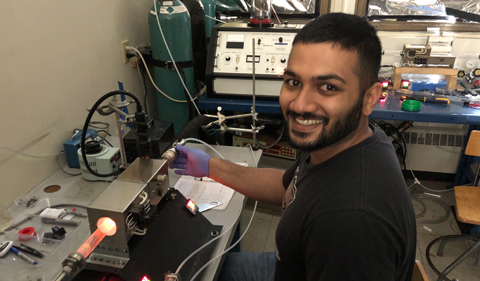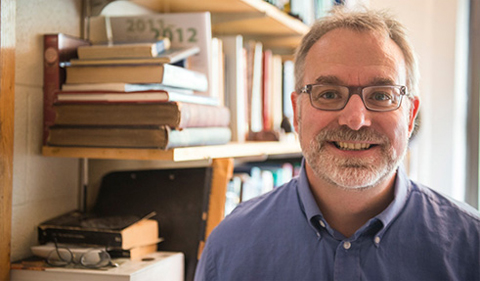
Thushan Wickramasinghe in his lab
By Ling Xin
NQPI editorial intern
Ohio University physics doctoral student Thushan Wickramasinghe presented his latest research on two-dimensional transition metal dichalcogenides at “The Ohio State University Materials Week” in Columbus in May.
Wickramasinghe works with Dr. Eric Stinaff, Associate Professor in Physics and Astronomy and a Nanoscale and Quantum Phenomena Institute member.
Two-dimensional transition metal dichalcogenides (TMDs) materials have a number of important optical and electrical properties and are developed as building blocks of new devices. However, the current technologies to grow them are neither simple nor efficient enough for large scale production and industrialization. In his presentation, Wickramasinghe focused on a unique modification of the chemical vapor deposition technique used to grow MoS2 (molybdenum disulfide), developed in Stinaff’s lab, which introduces naturally formed metal or metal oxide contacts directly on the sample.
“Instead of completely sulfurizing an ultrathin Mo layer, the TMD material grows on—and away from—the thick molybdenum patterns across the Si substrate, leaving naturally contacted TMDs,” said Wickramasinghe. “We are the first to develop this technique, and we plan to publish our results very soon.”
These findings were first reported by Wickramasinghe in a poster that received the first-place award at this year’s NQPI poster session and the second place at Ohio University’s 2019 Student Research and Creative Activity Expo. Doctoral students Gregory Jensen and Ruhi Thorat are also part of the team that is pushing these new developments.
Graduating with a Ph.D. this summer, Wickramasinghe said he has been greatly inspired by the research skills and teaching abilities of his superviser Stinaff. The next step in Wickramasinghe’s career is to accept a teaching position at California Polytechnic State University in San Luis Obispo, where he plans to teach, continue his research, and further his collaboration with Stinaff.



















Comments